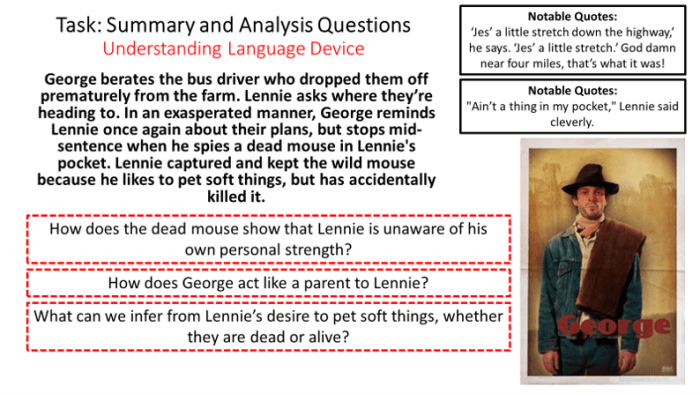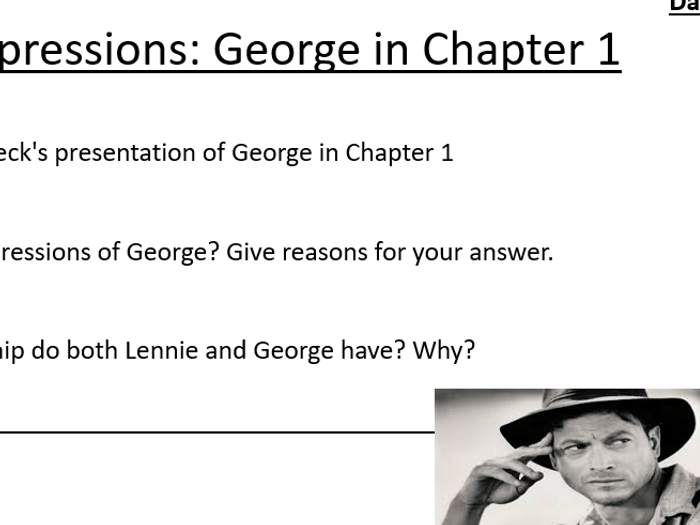Of mice and men chapter 1 questions – Embarking on an in-depth exploration of ‘Of Mice and Men’ Chapter 1, this analysis delves into the intricate tapestry of characters, setting, themes, and literary devices that shape the novel’s foundation.
Through meticulous examination and textual evidence, we unravel the complexities of George and Lennie’s relationship, the evocative power of the setting, the profound themes embedded within the narrative, and the masterful use of literary devices that enhance the storytelling.
Character Analysis

John Steinbeck’s “Of Mice and Men” presents a complex and compelling duo in George and Lennie. Their contrasting personalities and shared aspirations shape their relationship and drive the narrative.
George
George, the pragmatic and intelligent of the pair, serves as the voice of reason. His sharp wit and quick thinking often guide their decisions, yet he harbors a deep compassion for Lennie’s vulnerability. Despite his impatience with Lennie’s limitations, George remains fiercely loyal, driven by a sense of responsibility and shared dreams.
Lennie, Of mice and men chapter 1 questions
Lennie, the physically imposing yet mentally challenged giant, embodies the innocence and vulnerability of the marginalized. His immense strength is offset by his childlike simplicity and dependence on George. Lennie’s longing for companionship and acceptance often leads him into trouble, highlighting the challenges faced by those on the fringes of society.
Symbolism of Names
The names “George” and “Lennie” carry symbolic significance. George, the protector, represents the strength and stability of the established order. Lennie, the dependent, embodies the fragility and vulnerability of the marginalized. Their contrasting names foreshadow the challenges and tensions that arise in their relationship and the broader social context.
Setting and Atmosphere

John Steinbeck’s “Of Mice and Men” is set in the Salinas Valley of California during the Great Depression. The story takes place on a ranch, where the main characters, George and Lennie, are migrant workers.
The setting has a significant impact on the characters. The harsh economic conditions of the Great Depression force George and Lennie to work as migrant laborers, which is a difficult and unstable life. The ranch is a place of isolation and loneliness, and the characters often feel like outsiders.
The natural surroundings, such as the Salinas River and the surrounding mountains, are both beautiful and dangerous.
Weather Conditions
The weather conditions in the opening chapter contribute to the mood and tone of the story. The chapter begins with a description of a hot, dry day. The sun is beating down on the characters, and the air is thick with dust.
This weather creates a sense of oppression and hopelessness. As the chapter progresses, the weather changes. A storm begins to brew, and the wind picks up. The storm symbolizes the impending tragedy that will befall the characters.
Foreshadowing
The opening chapter of “Of Mice and Men” is filled with foreshadowing. There are several hints that suggest that something terrible is going to happen. For example, George tells Lennie that he is “gonna get into trouble” if he doesn’t listen to him.
Lennie also has a dream in which he sees a dead mouse. These events foreshadow the tragic events that will occur later in the novel.
Themes
The first chapter of John Steinbeck’s “Of Mice and Men” introduces several significant themes that resonate throughout the novel. These themes explore fundamental human experiences and provide insights into the complex relationships between individuals.
Loneliness and Isolation
Loneliness and isolation permeate the lives of the main characters in the novel. George and Lennie, the central duo, are outsiders in the harsh world of migrant ranch work. George, despite his pragmatic nature, often feels a sense of isolation as he grapples with the responsibility of caring for Lennie.
“He was too lonely and he was afraid. He was lonely because he was afraid, and he was afraid because he was lonely.” (Steinbeck, p. 1)
Lennie, with his intellectual limitations and social awkwardness, is even more isolated. He longs for companionship and understanding but often finds himself rejected and misunderstood.
The American Dream
The American Dream of prosperity and success is a central theme in the novel. George and Lennie share a dream of owning their own land, where they can live independently and escape the hardships of their current existence.
“We’ll have a little house and a couple of acres an’ a cow and some pigs… And we’ll have a place to go to. We’ll have a home.” (Steinbeck, p. 14)
However, their dream is constantly challenged by the harsh realities of their situation and the prejudices they face as migrant workers.
The Power of Friendship
Despite the challenges they face, George and Lennie’s friendship remains a beacon of hope and resilience. George, despite his occasional frustration, is fiercely loyal to Lennie and sacrifices his own well-being for his friend.
“I got you. You don’t need to be scared. I got you.” (Steinbeck, p. 31)
Their friendship serves as a reminder of the importance of human connection and the strength that can be found in mutual support.
Literary Devices: Of Mice And Men Chapter 1 Questions

In the first chapter of “Of Mice and Men”, Steinbeck employs a range of literary devices to enhance the storytelling and create a vivid and immersive experience for the reader.
Similes and Metaphors
Steinbeck uses similes and metaphors to create vivid and relatable imagery. For instance, the Salinas Valley is described as “a funnel-shaped gap” that “poured out into the sloping grasslands” like “a great chocolate cake.” These comparisons evoke a sense of the vastness and fertility of the land, while also hinting at the underlying tension and danger that lies beneath the surface.
Imagery
Steinbeck’s use of imagery appeals to the senses and creates a strong impression of the setting and characters. The “small, yellow flowers” that bloom along the riverbank contrast with the “dry, sun-baked” hills, highlighting the harsh and unforgiving nature of the environment.
The “brown face” of George and the “pale face” of Lennie emphasize their contrasting personalities and suggest the inner struggles they face.
Foreshadowing and Symbolism
Steinbeck also uses foreshadowing and symbolism to create a sense of foreboding and to hint at the tragic events that lie ahead. The “dead mouse” that Lennie crushes in his hand foreshadows the death of Curley’s wife, while the “tall sycamore tree” near the clearing symbolizes the hope and refuge that George and Lennie seek.
Questions Often Asked
What is the significance of George and Lennie’s names?
The names George and Lennie symbolize their contrasting personalities and roles in the novel. George represents reason and responsibility, while Lennie embodies strength and innocence.
How does the setting of the novel contribute to the story?
The isolated ranch setting reflects the characters’ isolation and vulnerability, while the harsh natural elements foreshadow the challenges they will face.
What are the major themes explored in Chapter 1?
Chapter 1 introduces themes of friendship, loneliness, the American Dream, and the struggle against adversity.
How does Steinbeck use literary devices to enhance the storytelling?
Steinbeck employs similes, metaphors, and imagery to create vivid descriptions, evoke emotions, and foreshadow events.